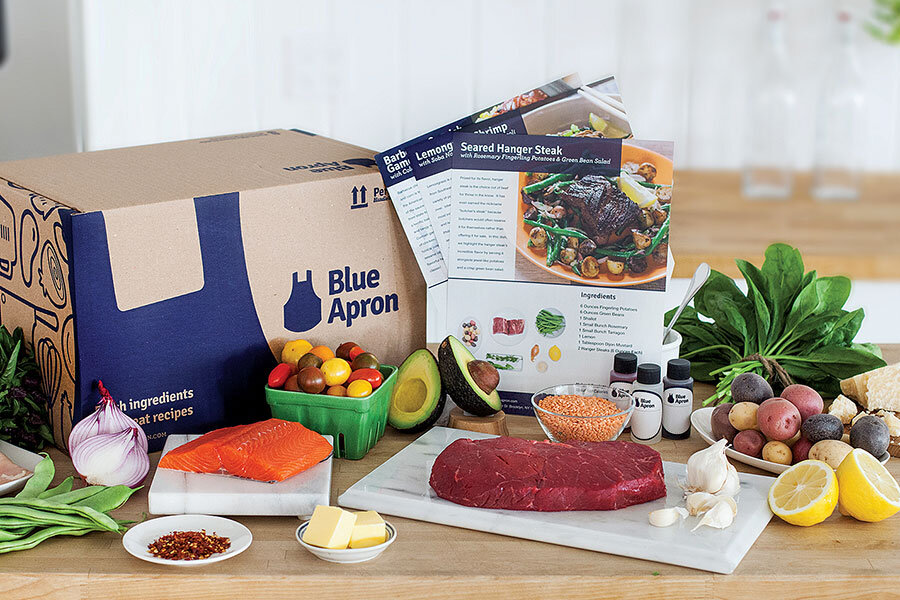Here's how meal kits stack up on cost
Loading...
With limited time between the end of the workday and dinnertime, meal kits like Blue Apron, Plated and HelloFresh allow you to skip the shopping and the recipe research. Delivered to your home in a box, the kits include all the ingredients you’ll need to make a meal for two to four people, along with recipe instructions.
We offer no culinary critiques of their offerings, but we have crunched the number of how they stack up in cost. Here are some observations and tips arising from our meal-kit math:
Prices can be surprisingly close to DIY. With the kit industry fairly new, competition is fierce and pricing is tightly competitive, with multiple companies offering kits for four people under a family plan for the exact same $8.74 per serving. If that sounds like a lot, you may be surprised by what we found when we compared the cost of two Blue Apron kits with making the same meal from scratch with ingredients we ordered online with two-day shipping--to duplicate the to-your-door convenience of the kits.
The first Blue Apron meal we researched, Thai Chicken Noodle Soup with Yellow Curry and Mushrooms, cost us about 10% more to make ourselves, while the other, Pimento Cheeseburgers with Roasted Carrots & Parsnips, came in at around 10% less.
Kits require no investment in extra ingredients. Kits come with just the ingredients required, in measured quantities. No muss, no fuss. By comparison, as we did when we duplicated the Blue Apron meals, you may find you’re forced to buy bigger packages than you need for the meal at hand, forcing you to pay for ingredients you won’t use that night. Once we factored in the extra cost of those for the Blue Apron meals we duplicated from scratch, the DIY efforts cost $7 and $2 more per serving, respectively, than the in-box soup and cheeseburger meals.
Sure, some of those ingredients are likely to be used soon--the mayo, sugar, and cheese left over from the cheeseburger recipes, for example. But it may be while, at best, before we make much of a dent in TK-ounce box of coconut milk powder or jar of yellow curry paste we bought for the Thai soup, or the pimentos we bought for the burgers.
On the flip side, however, the kits’ precise portioning allows for few or no cooked leftovers. Kits aren’t for you if you depend on the convenience and economy of, say, doubling the recipe and preparing enough at one time to feed you and your family for several meals.
A simple DIY meal would beat a kit on price. Meal-kit companies companies generally aim for interesting, high-end meals. Nothing as plebian as plain mac-and-cheese or simple chicken fingers is likely to be on offered, and such meals cooked from scratch would be less expensive than the recipes included in kits--perhaps by as much as $6 less per serving. In addition, part of the cost of using kits, or ordering DIY food online as we did, is paying for the convenience of home delivery of ingredients. Buying the ingredients you need in a brick-and-mortar store would likely cost less, especially if you can avoid extra gas expenses by stopping to shop on the way home, say, or taking a short walk to the store. (Of course, such shopping will likely take additional time, compared with buying via a few clicks of a keyboard.)
It’s easy to get a first meal kit for free. Kit companies appear to be as closely competitive on introductory offers as they are on ongoing pricing. Multiple companies are offering $30 off your first meal, or even first two meals, for four people, reducing the cost to $6 or so, or they’re simply offering the first box for free. So you’ve little to nothing to lose by trying out kits, from multiple companies, even if you doubt they’ll be for you in the long run. (You may, however, need to set up a plan that automatically delivers a box every so often, and cancel the arrangement if you decide the kits don’t satisfy your palate or meet your budget.)
Comparing Five Kit Companies
Most companies require you to subscribe to weekly or monthly deliveries, but you can typically cancel a shipment up to a few days in advance. Here’s how five major competitors stack up.
| Company | Cost per serving | Shipping |
|---|---|---|
| Blue Apron | $8.74-$9.99 | Free |
| HelloFresh | $8.74-$9.99 | Free |
| Plated | $12 | Free for $50-plus orders |
| Purple Carrot | $9.25-$11.33 | Free |
| PeachDish | $11.25 and up | Free for certain subscribers |
This story originally appeared on ValuePenguin.







